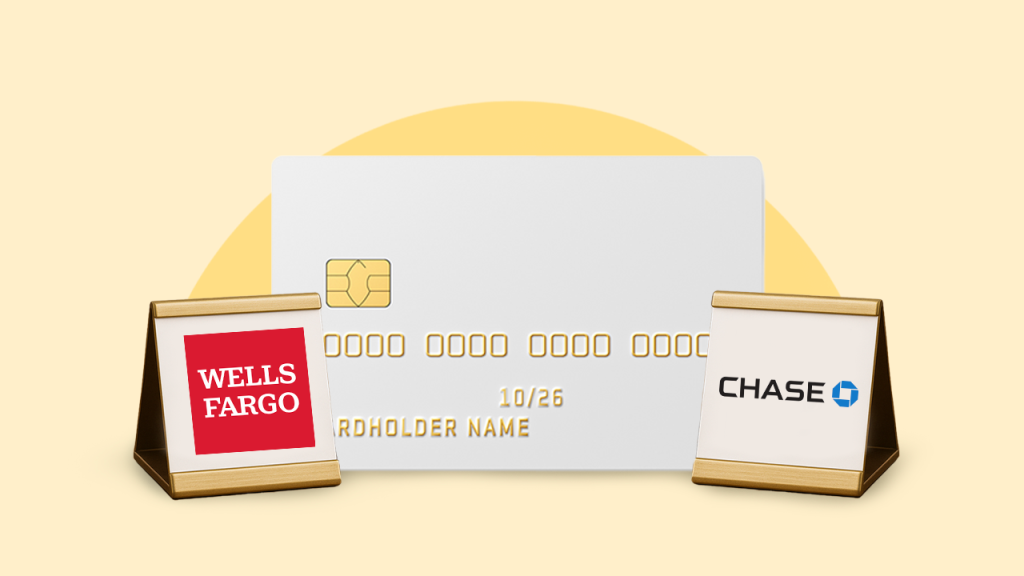Key takeaways
- Chase and Wells Fargo issue a range of popular rewards credit cards for consumers and small businesses.
- Options from both banks include cash back credit cards and travel credit cards that offer point transfers to airline and hotel programs.
- Before you choose, compare cards based on earning rates, redemption options, annual fees and included perks and benefits.
Between Chase and Wells Fargo credit cards, there are more factors to consider than meet the eye. You’ll want to take a close look at the cardholder benefits you can qualify for, yet also consider the footprint of the bank you’re considering. Meanwhile, you’ll want to compare the rewards credit cards each of these card issuers offers, as well as your chances of approval.
When it comes to comparing Chase to Wells Fargo as your future card issuer, consider each brand as a whole rather than just limited-time credit card offers that can (and do) frequently change.
Chase: Details and benefits
Chase has more than 4,700 brick-and-mortar bank branches, as well as over 15,000 ATMs nationwide. On the credit card front, Chase boasts almost 40 different rewards credit cards for individuals and businesses. Some of its cards are offered through its own loyalty program, which is known as Chase Ultimate Rewards.
Chase also offers co-branded credit cards with airline and hotel programs like Southwest Rapid Rewards, World of Hyatt, Marriott Bonvoy, British Airways and more.
Note that, unlike other credit card issuers, Chase does not offer any secured credit cards. Other than the Chase Freedom Rise® Credit Card* that’s designed for those who want to build credit, all Chase credit cards are geared toward people with good to excellent credit.
Wells Fargo: Details and benefits
Wells Fargo boasts more than 5,600 retail banking branches nationwide. It also has a network of more than 11,000 ATMs.
In terms of credit card offerings, Wells Fargo currently offers 11 personal credit cards and one business credit card. Unlike Chase, however, Wells Fargo doesn’t offer any premium travel credit cards with high annual fees. It does offer cards that earn travel rewards and transfer points to airline and hotel programs, as well as cash back credit cards.
Wells Fargo also, like Chase, lacks a secured credit card, nor does it offer any credit cards geared toward people building credit. For the most part, you’ll need good credit or better to qualify for a credit card from Wells Fargo.
Chase vs. Wells Fargo: At a glance
| Chase | Wells Fargo | |
|---|---|---|
| Branch locations nationwide | 4,700+ brick-and-mortar bank branches | 5,600+ retail banking branches |
| Number of ATMs | 15,000+ ATMs | 11,000 +ATMs |
| How many credit cards | Almost 40 different rewards credit cards for individuals and businesses | 12 credit cards for consumers and small businesses |
| Available rewards credit cards | Cash back credit cards, airline credit cards, hotel credit cards and flexible travel credit cards that earn Chase Ultimate Rewards points | Cash back credit cards, travel credit cards that earn flexible points, hotel credit cards and business credit cards |
| Card approval restrictions | The Chase 5/24 rule states that, if you’ve opened five or more cards with any issuer within the past 24 months, you won’t be approved for a Chase credit card; also note separate rules for “families” of cards | 48-month rule that limits cardholder bonuses on some cards |
| Cardholder benefits |
Some cards come with: |
Some cards come with: |
Chase vs. Wells Fargo credit card rewards programs
One factor to consider when picking a credit card is the type of rewards you’ll earn. This is a huge consideration when comparing Wells Fargo vs. Chase because the two rewards programs are vastly different.
Chase Ultimate Rewards
Once you begin earning points in the Chase Ultimate Rewards program, you can redeem them for travel through Chase Travel℠ (the issuer’s portal) or for cash back, gift cards, merchandise with Amazon or Apple and more. Your points will never expire provided you keep your account open.
Also, know that some Chase travel credit cards come with exceptional redemption options on the travel front. For example, the Chase Sapphire Reserve® gives you a Points Boost when you redeem for travel through Chase’s portal, as does the Chase Sapphire Preferred® Card and Ink Business Preferred® Credit Card.
Each of these travel cards also let you transfer your points to Chase airline and hotel partners at a 1:1 ratio, including:
Airline partners
- Aer Lingus AerClub
- Air Canada Aeroplan
- Air France-KLM Flying Blue
- British Airways Executive Club
- Emirates Skywards
- Iberia Plus
- JetBlue TrueBlue
- Singapore Airlines KrisFlyer
- Southwest Rapid Rewards
- United MileagePlus
- Virgin Atlantic Flying Club
Hotel partners
- IHG One Rewards
- Marriott Bonvoy
- World of Hyatt
Generally speaking, Chase Ultimate Rewards points are worth around 2.0 cents each when transferred to a high-value partner, according to our latest points and miles valuations.
Wells Fargo Rewards
How you can redeem your rewards depends on the Wells Fargo credit card you have. Many of the brand’s cards let you redeem for travel options like hotel stays, flights and rental cars. You can also redeem for gift cards, merchandise or PayPal purchases with most card options.
The Wells Fargo Autograph® Card and Wells Fargo Autograph Journey℠ Card were designed for frequent travelers, and it make it possible for Wells Fargo customers to transfer their rewards to a range of travel partners.
Current airline and hotel partners available with Wells Fargo include:
- Choice Privileges®
- Air France‑KLM Flying Blue
- Avianca Lifemiles
- British Airways Executive Club
- Aer Lingus AerClub
- Iberia Plus
- Virgin Atlantic Flying Club
We estimate Wells Fargo Rewards points are worth around 1.0 cents each with a high-value transfer partner, but the value you get will vary based on how you redeem them. If you sign up for the popular Wells Fargo Active Cash® Card, for example, your cash back “points” are worth 1 cent each.
Popular credit cards from each issuer
The chart below highlights some of the most popular credit cards from this issuer based on the type of rewards they offer.
Chase vs. Wells Fargo approval restrictions
When it comes to Chase credit cards, you have to consider the Chase 5/24 rule. This rule states that applicants who have opened five or more cards with any issuer within the past 24 months won’t be approved for any Chase credit cards.
Also, be aware that some Chase credit card “families” limit how often you can earn certain bonus offers and how many “members” of the family you can have at one time, and these rules apply on top of the Chase 5/24 rule. For example, the fine print for the Sapphire cards reads:
“The product is not available to either (i) current cardmembers of any Sapphire credit card, or (ii) previous cardmembers of any Sapphire credit card who received a new cardmember bonus within the last 48 months. If you are an existing Sapphire customer and would like this product, please call the number on the back of your card to see if you are eligible for a product change. You will not receive the new cardmember bonus if you change products.”
Like Chase, Wells Fargo has some rules that can limit who can be approved and earn the bonus on rewards credit cards. For example, fine print for the Active Cash card states:
“The new cardmember bonus may not be available to you if you currently have any other personal Sapphire cards open, previously held this card or received a new cardmember bonus for this card. We may also consider the number of cards you have opened and closed, as well as other factors in determining your bonus eligibility.”
When is Chase better?
While both issuers offer a range of popular credit cards, there are scenarios where you’ll be better off with a credit card from Chase.
When is Wells Fargo better?
When do Wells Fargo credit cards make more sense? Consider signing up for one of the bank’s credit cards if any of the following apply.
The bottom line
Do your research before applying for a Chase credit card or a Wells Fargo credit card. Even with the basic information we’ve shared, the plethora of cards each issuer offers makes it necessary to compare all your options.
A minimal amount of research can help you land the ideal rewards credit card for your needs and goals. Will it be Wells Fargo or Chase in the end? Only you can decide.
The information about the Chase Freedom Rise® Credit Card, Chase Freedom Flex®, Wells Fargo Attune℠ Card, Signify Business Cash℠ Card, World of Hyatt Credit Card, IHG One Rewards Premier Credit Card, Aeroplan® Card, British Airways Visa Signature® Credit Card and Slate Edge® credit card has been collected independently by Bankrate.com. The card details have not been reviewed or approved by the card issuer.
Why we ask for feedback
Your feedback helps us improve our content and services. It takes less than a minute to
complete.
Your responses are anonymous and will only be used for improving our website.
Help us improve our content
Read the full article here












